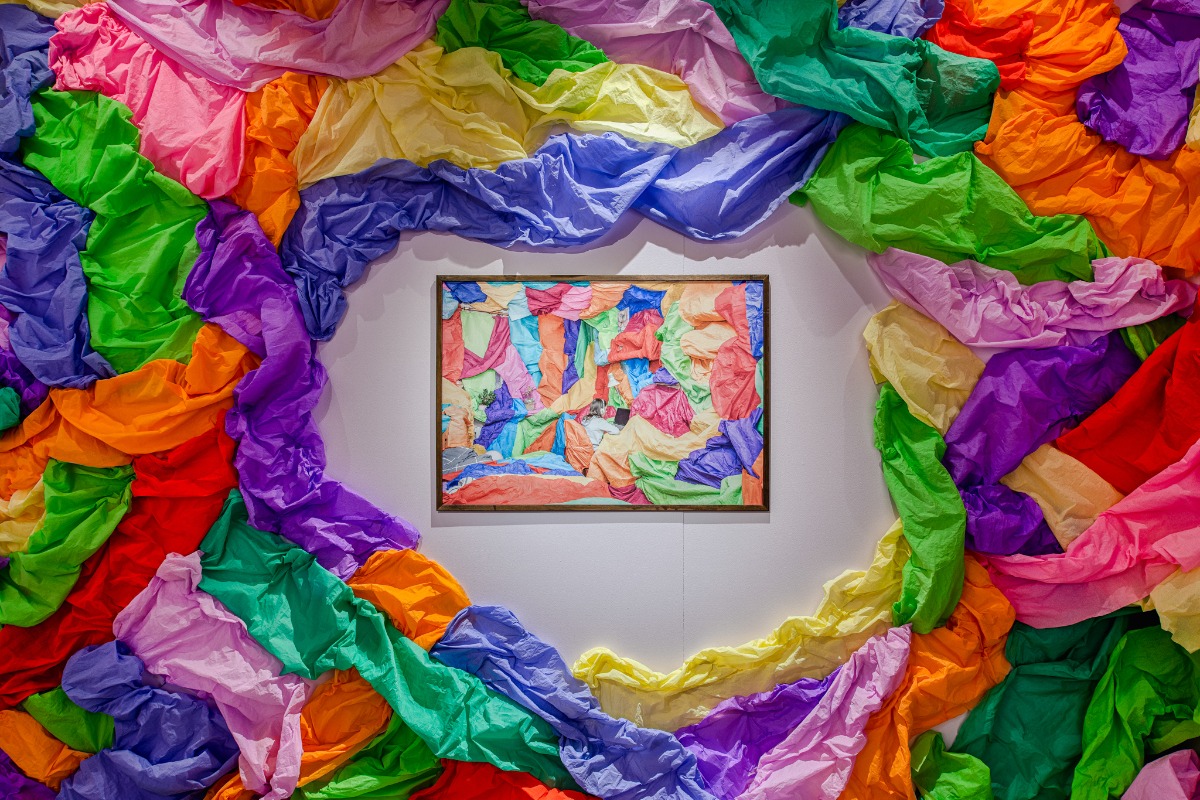
The Room Inside a Room
A conversation with Polish artist Michalina Kacperak, whose exhibition Soft Spot is on view through 18 June 2023 in the Intro Hall of Riga Art Space.
The NEXT 2023 off-year programme of the Riga Photography Biennial opened in late April and will run until late July, comprising eight shows dispersed over time. One of them is a solo exhibition by the young Polish photography artist Michalina Kacperak. The NEXT programme, taking place once every two years, is dedicated specifically to young artists from the Baltic countries and other regions of Europe at the onset of their careers in photography. It was decided to choose so-called “difficult subjects” as the focus of the 2023 edition of the programme, i.e. issues that are frequently passed over or avoided for fear of provoking an overly strong reaction or discord.
For Michalina Kacperak (1993), a subject of this kind is her personal story of life in a family where the father is an alcoholic. Michalina is the eldest of four daughters who grew up in this family. It was the courage and imagination of the artist’s youngest sister Zosia, who is now 13, that served as inspiration for the project. Attempting to create for herself a safe world within this unstable familial space, Zosia had transformed her room into a “soft spot”, a real refuge with walls covered in colourful drawings and filled with constructions made of vibrantly coloured yarn, dolls, figurines, toys, games, and pieces of burst balloons.
Initially, Michalina’s plan was simply to record this space that was jam-packed with complete metaphors diffracting an experience that was so familiar to her; eventually, however, the artist started transforming the original compositions and creating her own installations. Zosia also became an active contributor; at some point, the two sisters were also joined by their father.
Michalina Kacperak. “Soft Spot”. Exhibition view at the Intro Hall of Riga Art Space. Photo: Ingus Bajārs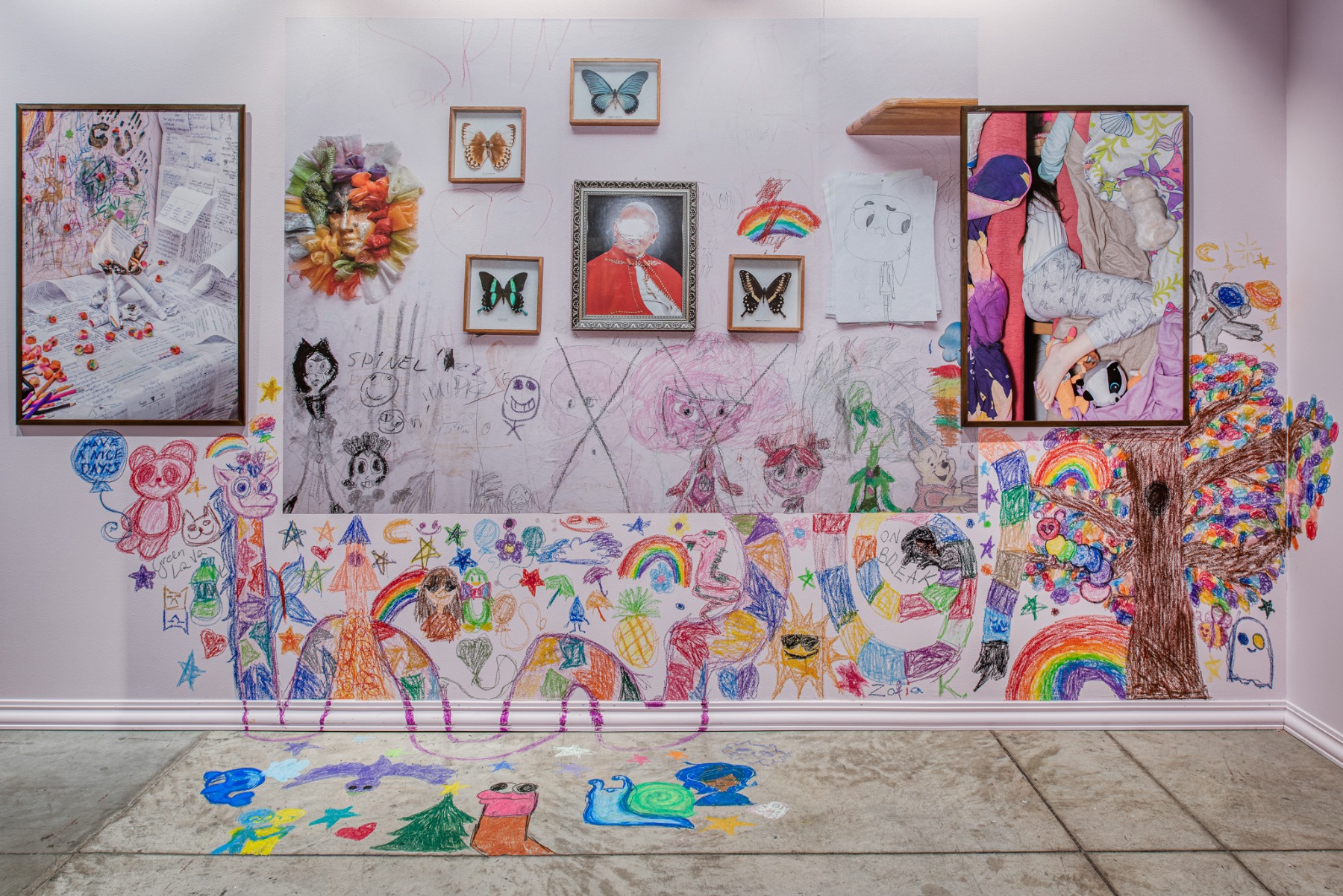
“Confronting the subject of your father’s addiction and growing up in a dysfunctional family requires great courage and openness, especially in Poland, where alcoholism tends to be downplayed, treated as a taboo, and shamefully swept under the carpet. However, a long-awaited change is observable in society. The young generation, especially women, are starting to speak out about their experiences.” According to the introductory text to the exhibition by Katarzyna Sagatowska – founder of the Jednostka Gallery, which focuses on contemporary Polish photography and collecting – Michalina “weaves a multi-faceted narrative about a world in which no one is who they should be. The adults are children and the children are adults. And yet no one in the story is unambiguous. Although Kacperak feels anger, irritation and sorrow, she is also compassionate. Rather than blaming or excusing anyone, she seeks to understand how the machinery behind her family works. She also wants to close a certain stage of her life, to get out of the home. Most importantly, however, by exploring her own and Zosia’s experiences, she strives to make heard the messages being sent by children of alcoholics.”
Michalina Kacperak. “Soft Spot”. Exhibition view at the Intro Hall of Riga Art Space. Photo: Ingus Bajārs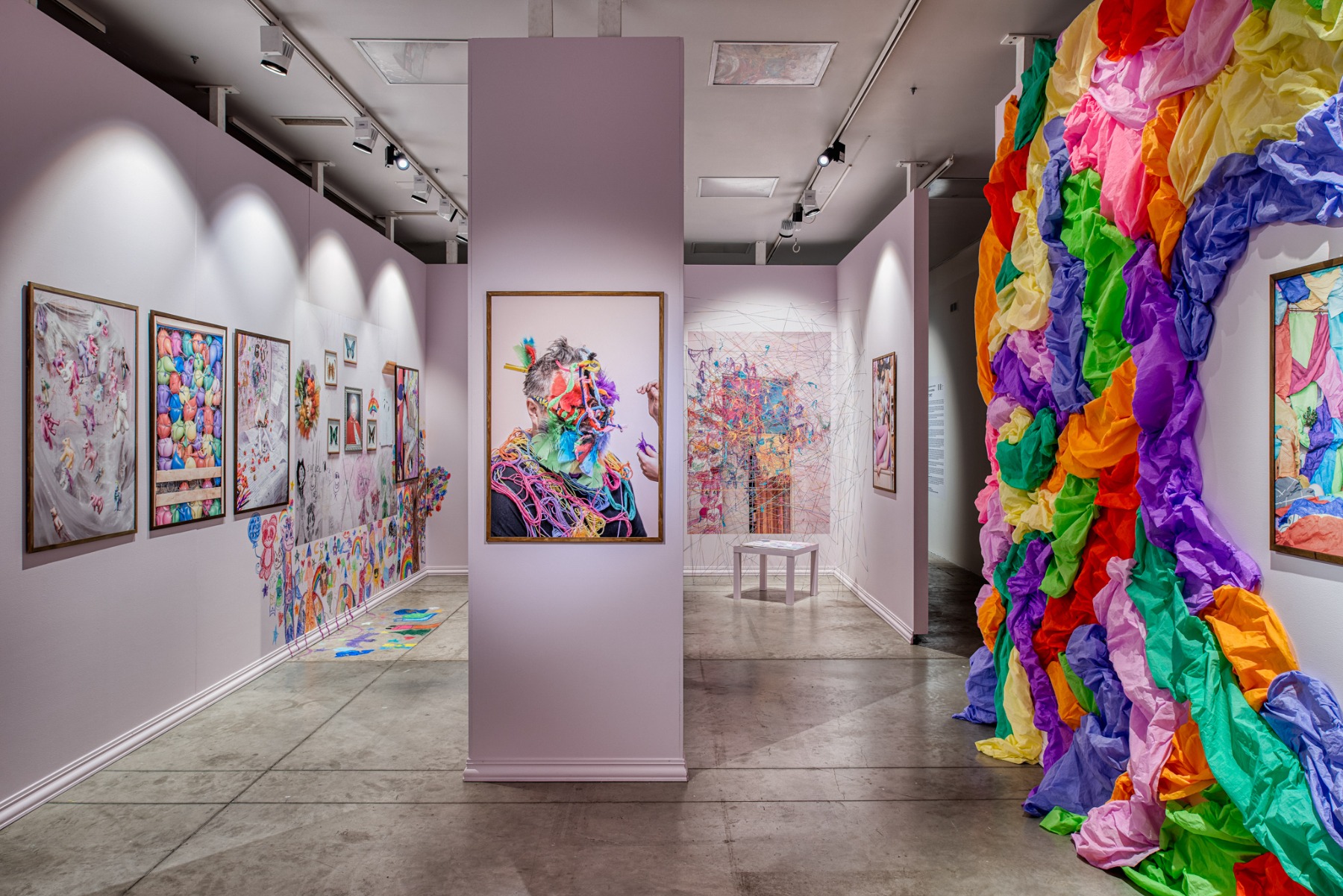
The project was mounted in Riga by curator Inga Brūvere, head of the Riga Photography Biennial, who played an active part in organizing the exhibition space and the actual creation of this “room within a room”. The exhibition is presented in association with the Jednostka Gallery and the National Film School in Łódź. It was at this film school that Michalina went on to study after obtaining a master’s degree in philosophy, choosing to specialize in photography. She employs a number of imaging techniques in her work, from digital and analogue photography to collage and archive use. The most important part of her art deals with complex personal stories, foregrounding subjects related to childhood, memory, social isolation and identity in the broadest sense of the word. The artist is a laureate of the 12th Circulation(s) Festival of young photography in Paris, while her Soft Spot project won the BarTur Photo Award in the Ann Lesley BarTur Student category in 2022.
We spoke with Michalina Kacperak on the eve of the opening, in the backroom of Riga Art Space where the staff escape to drink coffee around a big round table. Michalina carefully considered each question, sometimes pausing mid-answer as if searching for the most correct, most genuine words. It was very obvious that it was not simply a narrative for her but a completely personal and emotionally sensitive story. She has really succeeded in converting this story into a universal healing narrative, using the actual magical power of art as a skill of working with meanings, gestures and materials that interact to create convincing and forceful symbols.
Michalina Kacperak at the opening of the exhibition “Soft Spot” / Intro Hall of Riga Art Space. Photo: Kristīne Madjare
You first studied philosophy, and only then moved on to photography...
Yes, I studied philosophy in Poland, and then I went to film school in Lodz, where I learned photography, too. It's been ten years of studying.
So you changed the discourse: from words to images.
In some way – yes, but I think images and the visual arts were always on my mind, even when I studied philosophy. Because aesthetics, especially the aesthetics of photography, were my main interest in my philosophy studies. I was already creating images at that time, but I wanted to develop myself more intellectually because I felt that was important.
Was philosophy helpful for gaining a deeper understanding of your vision in the photography field?
When I started, I thought that maybe once I understood more, it would be easier, but actually, philosophy complicated everything… but in a good way. Because it is complex: reality, perception – visual perception and other kinds… Philosophy helps us be aware of it. It changed my understanding of what sort of information pictures can actually give us. Because a long time ago, when I first started photography, I thought that it brings insight because it is a simple way to show the facts. But philosophy helped me to understand that photographs can provide some truth, but in a different way: they give more awareness of their author – myself, my point of view, my feelings, my inner world.
You said that photos are not exactly about what they show. The photos in the exhibition are quite bright in terms of colour, but the viewer definitely feels that there is something dramatic inside.
Yes, they are bright and colorful because the direct inspiration for these images was my sister's room, and it is actually full of colours. At first, I documented this place – I just photographed it as it was. I wanted to show that in a world that seems happy, bright and playful, there could be a lot of pain and other hard emotions hidden underneath. My sister’s life and my own childhood took place in just such a world, one where underneath the happiness there were other issues.
Michalina Kacperak. “Soft Spot”. Exhibition view at the Intro Hall of Riga Art Space. Photo: Ingus Bajārs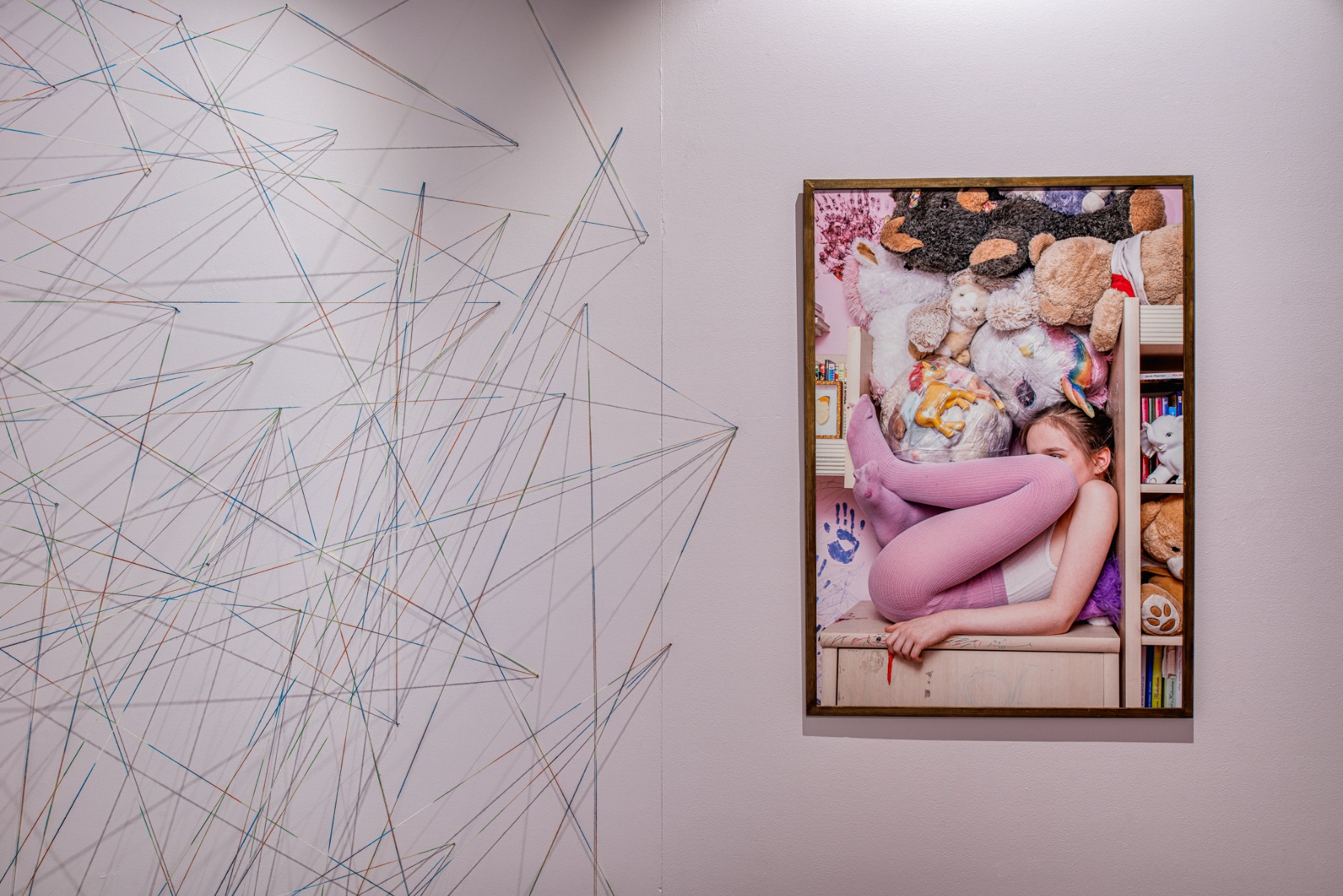
There is also a feeling of heaviness in this “very happy childhood”. For instance, in the photo where there are a lot of these soft toys heaped on top of your sister, it almost looks like she is trapped under a pile of soft ruins or rubble.
This depicts a certain feeling of pressure. Pressure that is a mix of good and bad things. My goal was to tell a story about spending your childhood in a place where you feel like you’re in some kind of a trap. And you don't know exactly how to escape or how to help yourself. There are a lot of scratches and anxiety in these pictures. I wanted to show in every photograph something that is difficult to deal with, even for the viewer.
The mix of these specific aesthetics and emotions – feeling good and soft and safe mixed with fear and unconsciousness and so on – is very important here. Because this is the truth that these pictures can express.
Your sister was your collaborator during these photo sessions.
It was very important for me to make my sister feel comfortable in this. I just wanted her to play with it and to feel good, to take advantage of this experience, and I also wanted to experience it with her. Because I actually learn a lot from her – a lot about myself and about enjoying life and anything, actually. I think that in some way, she's smarter and braver than me. She deals better with these things. This collaboration was very important because it is also a kind of therapy. But “therapy” is a big word; I think our process is something more and something less at the same time.
How did your sister perceive this experience?
I started to develop this idea when she was about eleven. We had a lot of conversations about it. I always try to treat her fairly, answer any questions she may have, and explain everything that she wants explained. When I don't know the answer, I tell her so. In a sense, I treat her like an adult. Every question she asks is important for me, and I try to treat her with respect.
Of course, she's aware of the problem that exists in our family because she lives there. It's not a secret for her. But the most important thing was not to hide it or pretend that this problem doesn't exist, but to instead face it and help her deal with it and process it and understand some things. To help her realize that it is not her fault. When you hear the common assertion that “children from families with alcoholic problems feel guilty”, it sounds absurd. Yes, it is absurd, but it is also very true. Children feel guilt, and they are sure that it is their fault that something is wrong at home. So, I really wanted to help her understand that it's not about her and that she's okay. Most things in the world she lives in don't depend on her; it is not her fault. I myself had to realize this as an adult.
Michalina Kacperak. “Soft Spot”. Exhibition view at the Intro Hall of Riga Art Space. Photo: Ingus Bajārs
I heard that she also came to Riga and made some drawings at the exhibition.
Yes, she came. She actually just finished the drawings a few hours before we met. It was very important to include her in the process of creating the exhibition because this story is also about leaving this place mentally, this home. Sometimes people cannot leave this place for their whole life – they are adults, they don't live with their parents anymore, but their minds are still there. It is a symbolic gesture that she can go out and show her point of view, her creativity, and that she can feel free doing anything she wants. It’s an opportunity for her to feel important because that is also an issue: we, the children of alcoholics, often feel that we are not important enough. So I gave her this opportunity to do this gesture of freedom because for me, her drawings on the walls in her room are a gesture of freedom as well as a manifestation of it. And I also wanted her to do it outside of her home.
So, these drawings were originally on the walls of her room.
Yes, it's important because the drawings that are at the exhibition have been hung below the big picture, which is the first photograph I took for this project. It presents the wall as it was in her room. I didn't do anything with it. Yeah, there are many drawings on this wall; they are still in her room and they are expanding. So, this idea to take her to the exhibition to make drawings was very natural.
How old is she now?
13. Almost 14. Yes, it was a long process. I started it three years ago. But it takes a lot of time because I decided to take pictures only in her room. And I don't live with my parents anymore, of course; I live far away. So if I want to take pictures, I have to go back and… still deal with some problems there. It's difficult emotionally. It can be exhausting.
Michalina Kacperak. From the series “Soft Spot”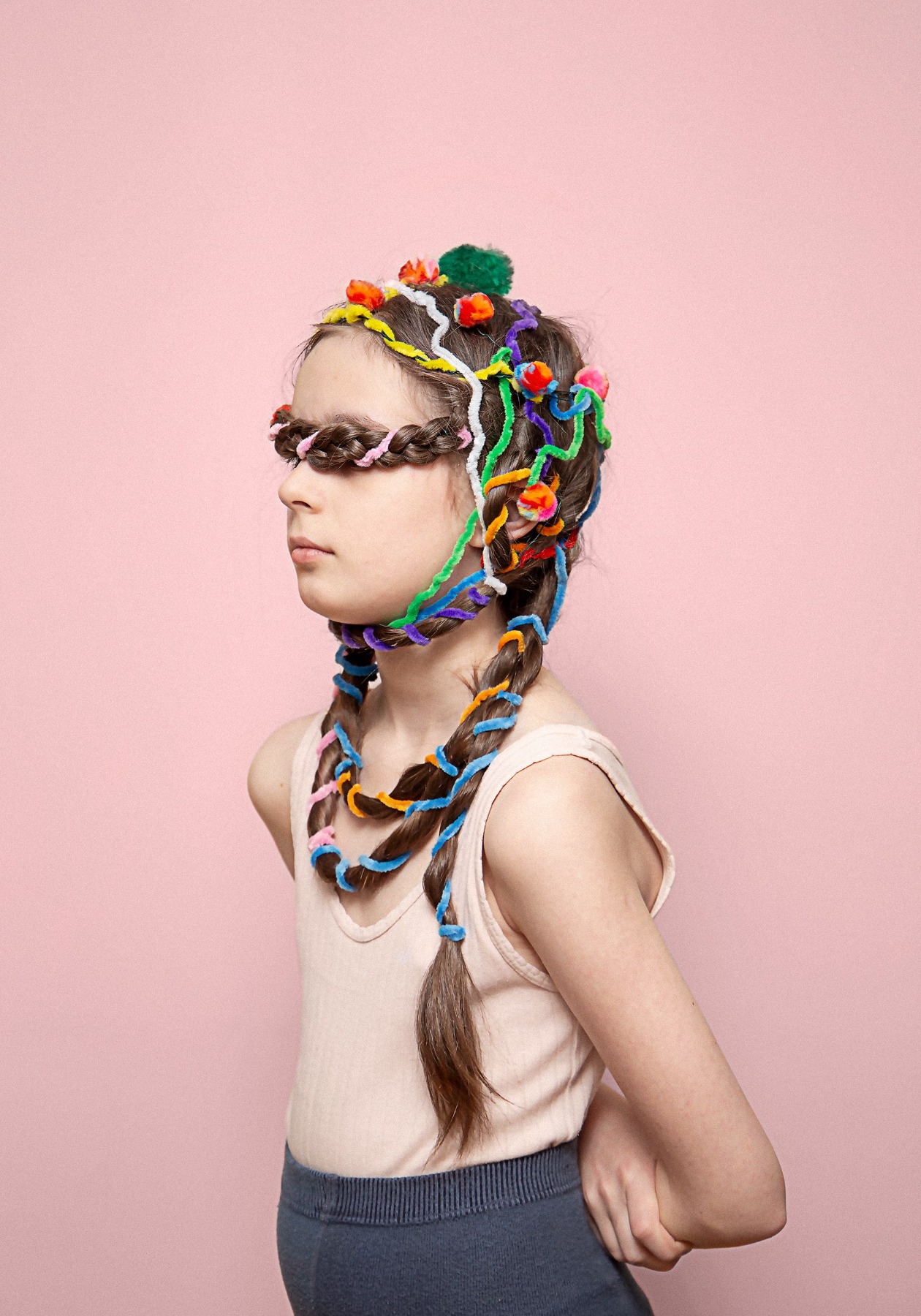
I think that people who don't know the background of the images may also feel a story inside – something about the fragility of childhood itself. Mostly because parents today understand that they cannot be sure what kind of future awaits us – the whole planet, for that matter – so they want to give their kids everything they can, be it hundreds of toys or something else. There is a kind of a drama there.
I'm glad you said that because it is important for me that [the show] tells this particular story, but it is also about something more universal – about childhood in general and about children's actual needs: when they have too much of this and not enough of what they really need. I wanted to give a voice to children, and also to myself as a child in the past, so that they can tell us what they actually need to be happy. Of course, it's quite simple and it doesn't depend on material things.
Michalina Kacperak. From the series “Soft Spot”
This concept of a happy childhood as a special time in our lives is quite new. Before the 16–17th centuries, children were not perceived as something special – they were seen as small and inexperienced adults. There was no cult of childhood akin to today’s “Disneyland zone”, of course. We live in a time when there is this cult of childhood, of how this childhood should be; sometimes it helps, but sometimes it leads us in the wrong direction. Yesterday I was speaking with a theatre director the from local puppet theatre and he said that parents always bring their kids to the performances that are somehow connected to their own childhood. They want to share the experiences of their childhood and their memories with their children – have it serve like a guide in some way. But we live in a society that has changed quite a lot. How can we be open to this idea that childhood can be like this, but it could also be like that…
I’m not sure if I know the answer; I think I am still discovering all possible answers. Doing this project is kind of like answering this question because when you are an adult, even if you don't have children, it is important to be aware of what is needed for a good childhood. Also, I don’t think you can be mentally healthy as an adult if you don't take care of this inner child in you.
I also wanted to show my father as a person that has a lot of pain inside him, and that his inner child was also hurt very much. He's holding this inner child very deep in himself. That’s why I also created portraits of my father in this colourful and playful way. And we played with him while taking these pictures. I wanted to draw him into this kid's world; I wanted him to come back to his childhood in some way. And we all are children in this project – my father, me, my sister. Because it was a healing process, it was also very important to let it go, to let it out.
Both of my parents hurt us, hurt themselves, and hurt each other and so on. But to get through the healing process, I just had to let it all go – to feel free. And it's also about that – to let some things go. Because there are too many feelings and emotions and you’re holding on to this past so hard that you cannot live right now in your present because you’re constantly still there, in this childhood. For me, I actually had to go back there in real life. And metaphorically as well – to deal with some things so that I can finally let go of them properly.
Michalina Kacperak. From the series “Soft Spot”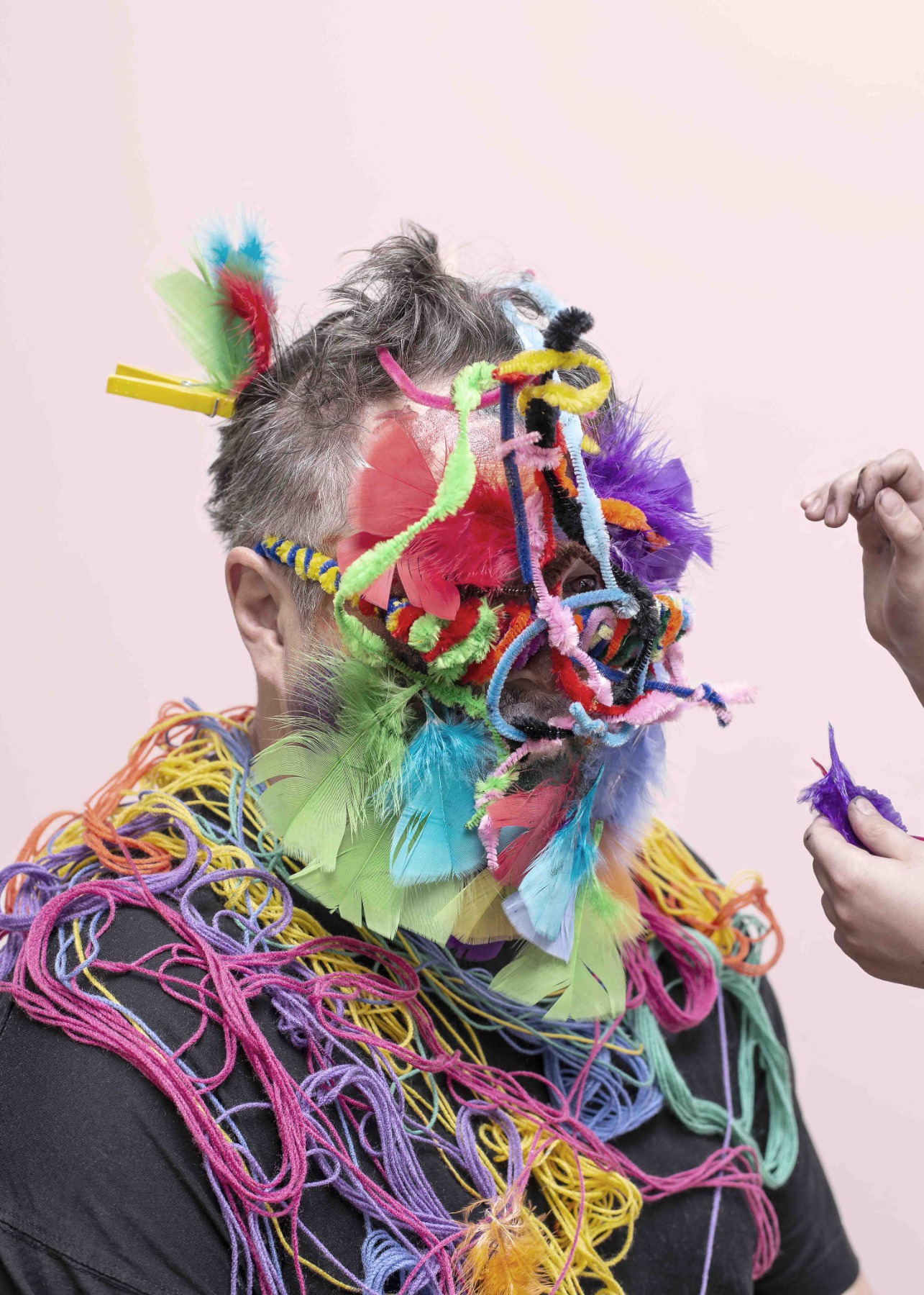
How did your father perceive this project?
At first, it was difficult for him. Both of my parents didn't want to know exactly what I was doing and why. But when I took the first pictures, I realized that it is possible for people outside of our family to hear our story, and the moment had come when I had to talk with them to explain what I'm doing and why. It was surprising to me that my father took it very well. Moreover, he told me that it is important for me to do it. This was a very big deal for me because it’s very likely that we wouldn't have had such a conversation if I hadn't taken these pictures. And after some time, he joined the project himself. I thought that maybe we can just try to do a portrait of my father. But it was a very difficult process for me emotionally because I had to touch him physically. And there hadn’t been much physical contact between us in the last years.
He sat on the chair, in front of the camera, fully aware of what we are doing and what the story is about. I asked Zosia, my sister, to make on his face whatever she wants. She was very, very excited – it was fun for her. For me, it was a very symbolic moment. And very important. My father let her do anything she wanted. And I took a few photographs then. But I chose to put in the exhibition the only photograph in which he looked directly at the camera. His face is covered but there's a little hole in which you can see his one eye looking at you. He had connected with me while I was doing this. I treat this look as a kind of willingness to make a connection as well as a signal that he wants to help me with dealing with it…
And did the process help him understand the problems that exist?
Well, I think in some way – yes. Because we talked about it a lot. And it was something new for us – talking about it and not covering it up, not pretending that there is no problem. I think that there's progress there, but also a lot of work to do for all of us.
Michalina Kacperak. “Soft Spot”. Exhibition view at the Intro Hall of Riga Art Space. Photo: Ingus Bajārs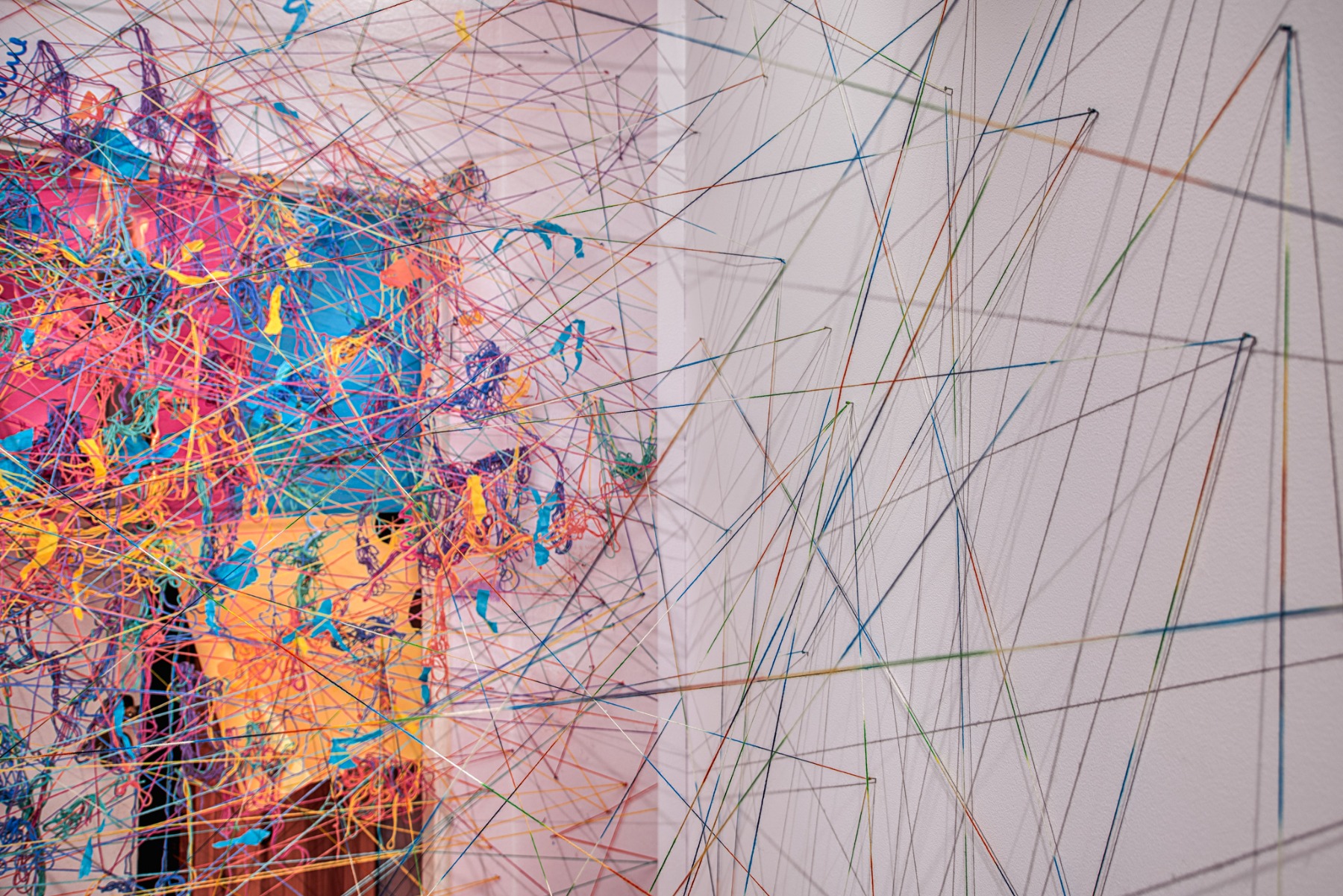
There are also a lot of objects in your exhibition. How can “real things” help photography make an impression?
Creating the whole exhibition as an object, “the room inside the room”, was the idea of Inga Brūvere, the curator and scenographer of the exhibiton. . However, this concept is strongly related to my own art practice. I think for my part, the decision to include objects and installations in the exhibition instead of just photography itself was due to two things. The first reason is that they tell a story about the space, the actual room, and they also represent the inner world of a child. I found the metaphors in my sister's room – in her way of dealing with the space, of arranging it, of making the objects. So for me, it was obvious and natural to include physical objects in the exhibition. I wanted to repeat some of the gestures she and I had used when taking these photographs.
The second reason for using objects is my personal interest in the potential of telling intimate stories through them. I use this in installations and even in a sort of performance while taking the photographs, the results of which can be seen in the exhibition. Besides, I find it extremely interesting to repeat a gesture in another space, in a new context and in the company of the photograph to which it refers. I think it helps to look at things, their story and, consequently, the story of people in a different way. In addition, it helps build an exhibition space that is a physical experience for visitors.
Michalina Kacperak. “Soft Spot”. Exhibition view at the Intro Hall of Riga Art Space. Photo: Ingus Bajārs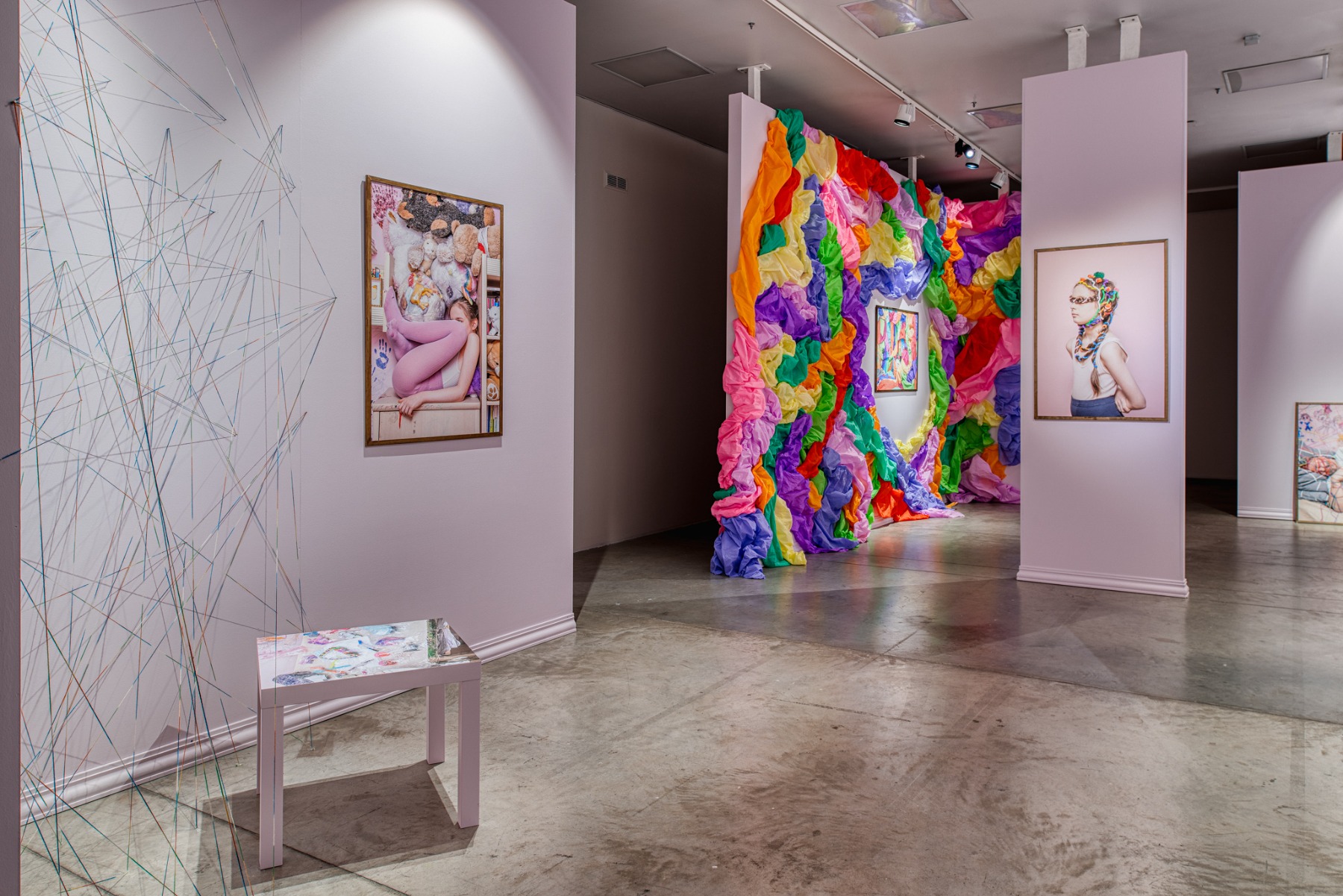
So in some way, it’s a space and a ritual in one.
I didn't actually think about this. But yes, it is some kind of a ritual, especially these drawings. On this wall in her room, there's everything. When my sister was learning how to write, she once wrote: “I don't want to be here”. But then on another day, when she was feeling good, she covered this and made some happy drawings on top. This wall shows everything that she has felt; I think it was her ritual or diary or something...I don't know. That’s just my interpretation, of course, because she never told me that it was her way of dealing with things. You know, she's still a child, so she probably doesn’t see it that way yet. But I think it is something along the lines of that. This ritual also proved helpful to me, and my sister actually lent me her world so that I could tell about my own. And that's why I started this project.
Title image: Michalina Kacperak. “Soft Spot”. Exhibition view at the Intro Hall of Riga Art Space. Photo: Ingus Bajārs